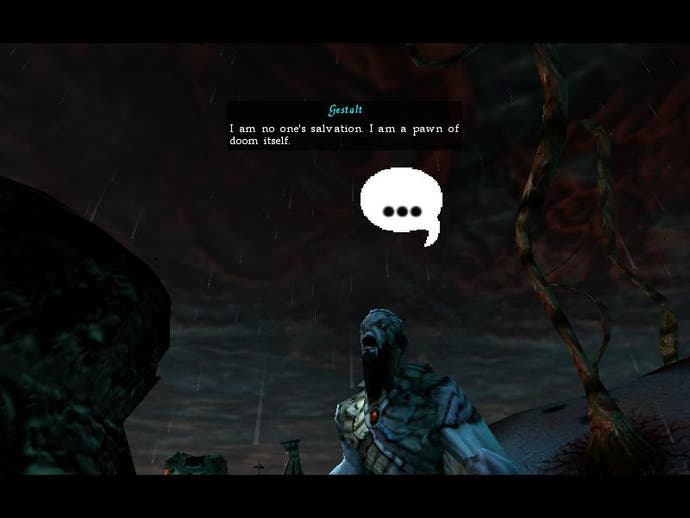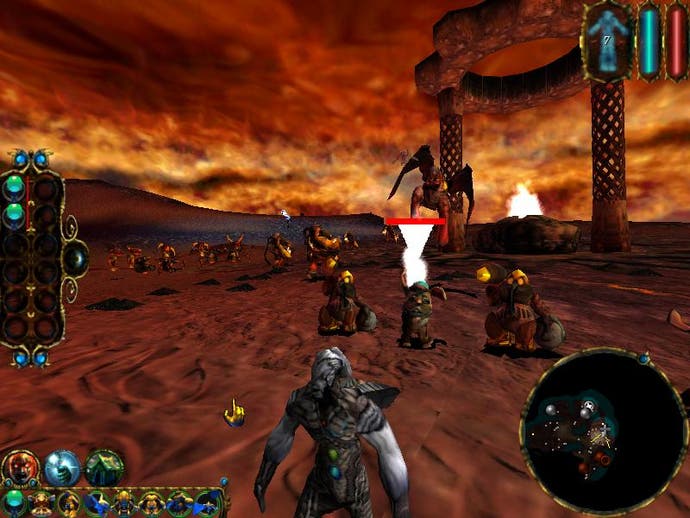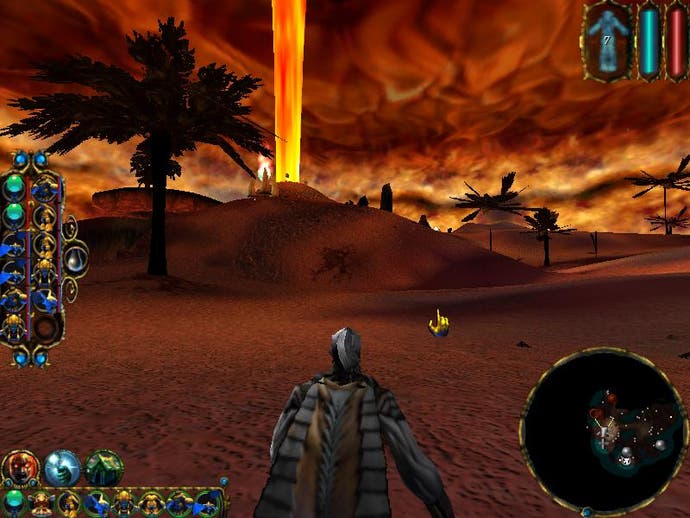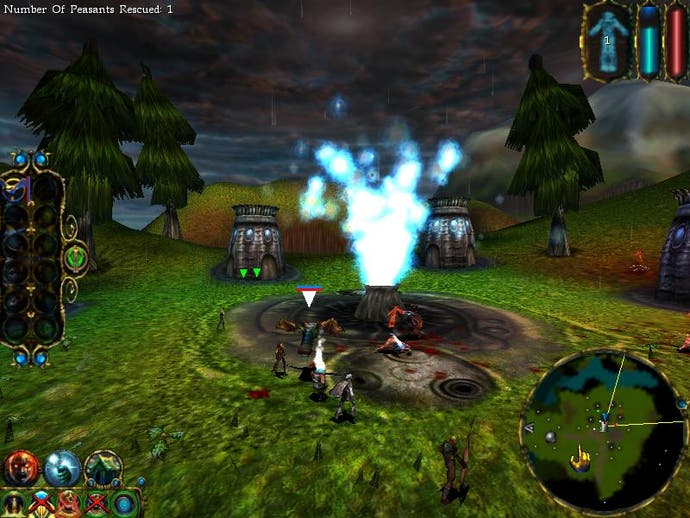Sacrifice
Review - can Shiny's third person action-strategy game live up to the hype?
If there is one thing Shiny is good at, it is self-promotion. Gospel choirs, street preachers, buxom beauties and midgets in diapers all played their part in publicising the company's last game, the cherubic third person action-adventure "Messiah". Compared to that, "Sacrifice" has had a positively low key entry, although it has been hyped almost incessantly in the press, and if you placed every screenshot of the game which has been posted on the web end to end, they would easily reach to the moon and back. Obviously no game could live up to this level of hype, but is Sacrifice a total disaster or merely a mild disappointment?

Towering Inferno
The basic premise of the game is certainly promising enough. You play a wizard with a murky past who finds himself in a strange world ruled by five argumentative gods, ranging from the tree-hugging Persephone to the evil god of slaughter, Charnel. Each of these gods will try to lure you to help them in the series of missions which make up the single player campaign, and you aren't forced to follow the same god throughout, although your choices will narrow as the plot progresses. This means that you can play through the game over and over again, and each time it will progress in a slightly different way, with only the central storyline remaining more or less constant.
Each of the five gods have their own range of spells and creatures which will become available to you as you carry out missions for them. For example, the god Pyro's speciality is fire - follow him and you will gain spells varying from your basic run-of-the-mill fireball to meteor storms and walls of flame. If you decide to switch back and forth between different deities during the game you will soon build up a wide range of abilities to smite your enemies with, from earthquakes to tornadoes and fire storms.
All of these spells are powered by mana, which can be harvested from the various resource points around the map by summoning a building known as a manalith, while the number of creatures which you can command at any one time is limited by the number of souls you have under your control. To expand your army you will need to summon sac doctors, who can pump the souls of your fallen foes back into their bodies, and then drag them off to your altar to be sacrificed. The altar is also the heart of a wizard's power, and the only way to defeat them is by desecrating their altar.

When Worlds Collide
At first sight then the game looks like a winner, with a typically bizarre Shiny concept, an intriguing storyline, and a range of oddball characters to interact with. But dig a little deeper and the flaws start to show through. The biggest problem is that the game just can't decide what it wants to be, and ends up hovering half way between action and strategy, making a rather mediocre job of both.
Much of this is down to the game's third person camera system, which seems to have been designed to make life as hard as possible. Although you can spin, zoom and rotate your view around your wizard, and it would have worked perfectly for a straight third person shooter, it just isn't flexible enough for a 3D strategy game. You can't zoom out far enough to get a clear view of the action going on around you, and without a free roaming camera it's impossible to tell what is happening elsewhere on the battlefield, apart from by gazing at the tiny 2D map in the bottom right corner of the screen.
This means that you usually find yourself wandering around the world with all your creatures formed up in a huge gaggle behind you, although you will want to leave a few behind chained up to your altar and manaliths to make sure the enemy doesn't wipe out your resources while you are half way across the map. Once you are into combat things tend to get rather chaotic, as the action is so fast paced that your carefully assembled formations are soon in disarray, and any thought of tactics goes straight out the window. In fact, the only real way to control your troops in the heat of combat is to pause the game while you give your orders, which isn't very satisfying. More often that not you simply end up running around trying to avoid enemy attacks, stopping whenever possible to lob offensive spells at the enemy and to heal friendly troops in an attempt to sway the battle in your favour.

America's Dumbest Creatures
Sadly the rest of the game just seems to enforce this rather unsatisfying style of play. The way that souls work, for example, means that you can't send troops anywhere without you, because if they stray too far away and then get killed enemy wizards will steal their souls before you can reach them. Given that you start most missions with far fewer souls than your enemies have, it is vital that you hold on to the ones you have and capture as many as you can from the enemy, but the only way to do this is to be with your troops in every single battle.
And while it takes a few seconds to summon up a sac doctor, and several more for him to pump an enemy soul back into its corpse, all you have to do to recover one of your own souls is to run over it. You will often see enemy wizards whizzing around like they are on speed, rushing through the middle of battles and picking up disembodied souls before you can capture them. This means that short of killing the enemy wizard (and thus forcing him to return to his altar to regenerate) it is very hard to capture souls, which tends to lead to a stalemate as you fight a series of pointless skirmishes which don't give either side any major advantage.
Even if you could afford to leave your troops to their own devices, the AI ranges from merely infantile to downright moronic. While some creatures (particularly trolls) will chase down enemy units without any prompting, often running straight into an ambush in the process, others will simply stand there and take damage from ranged attacks without bothering to get close enough to return fire unless you specifically order them to. The constant cries of "your creatures are under attack", usually swiftly followed by "your creatures are dying", soon become highly irritating...

Deep Impact
Apart from the story and voice acting, about the only other department that the game truly excels in is graphics, and it's easy to see why posting dozens of high resolution screenshots of Sacrifice every day has become a way of life for many gaming websites over the last year.
The worlds over which you are fighting are beautifully textured and covered in smooth rolling hills, towering mountains and gentle valleys, dotted with villages, windmills and other buildings. The effect is somewhat marred by the occasional polygon popping which occurs as the graphics engine adjusts the level of detail of the terrain and buildings on the fly to maintain a reasonable frame rate, but luckily you won't have time to notice this in the heat of combat. The sheer attention to detail is impressive as well. Rain falls from the dark and brooding skies, flowers sprout from the ground in the realm of Persephone, while flies buzz around the dead lands of Charnel, and there's always something going on to keep your attention.
The creatures are also nicely detailed, and the third person camera means that you have an up-close-and-personal view of them, whether you want it or not. Animations are funny and generally very life-like, although creatures often seem to be sliding over the terrain rather than running across it. The game's real highpoint though are the spell effects, which are simply spectacular. The sight of flaming missiles raining down on the battlefield, tornados lifting your men high into the sky, or the ground swelling up beneath your feet as an earth wizard unleashes his magic, is positively breathtaking.

Conclusion
If only as much attention had gone into the gameplay as has obviously gone into the graphics, Sacrifice might have been the classic 3D strategy game which we were all expecting. As it is the result is yet another oddball third person shooter from Shiny, with some rather dubious strategy elements which just don't seem to gel with the rest of the game.
Sacrifice isn't a bad game, just frustrating. If I drop dead from a heart attack tomorrow, it will be because of the massive increase in blood pressure I've suffered from while playing this game. The camera view is frustrating, the controls are frustrating, the AI is frustrating, the resource system is frustrating, the missions are frustrating, and above all the fact that this game isn't half as good as we were all hoping it would be is very, very frustrating.
-
Sacrifice screenshots

